The Dynamics of Vegetation Evapotranspiration and Its Response to Surface Meteorological Factors in the Altay Mountains, Northwest China
Abstract
1. Introduction
2. Data and Methods
2.1. Description of Study Area
2.2. Data Sources
2.3. Statistical Methods
2.3.1. Definition of Extreme Weather Events
2.3.2. Definition of Extreme Temperature Indicators
2.3.3. Definition and Calculation of Extreme Precipitation Indicators
2.3.4. Definition and Calculation of Standardized Precipitation Evapotranspiration Index (SPEI)
2.3.5. Climate Tendency Method
2.3.6. Correlation ANALYSIS
3. Results
3.1. Effect of Air Temperature on Evapotranspiration of Vegetation
3.2. Effect of Precipitation on Evapotranspiration of Vegetation
3.3. Effect of Drought on Vegetation ET
3.4. Effect of Extreme Weather Conditions on Vegetation ET
4. Discussions
4.1. Precipitation as the Primary Driver of ET
4.2. Complex Role of Temperature
4.3. Impact of Drought and Soil Moisture
4.4. Effect of Extreme Weather Events
4.5. Comparative Analysis with Previous Studies
4.6. Ecological and Management Implications
5. Conclusions
Author Contributions
Funding
Institutional Review Board Statement
Informed Consent Statement
Data Availability Statement
Acknowledgments
Conflicts of Interest
References
- Evans, J.; Geerken, R. Discrimination between climate and human-induced dryland degradation. J. Arid Environ. 2004, 57, 535–554. [Google Scholar] [CrossRef]
- Wan, J.Z.; Yum, J.H.; Yin, G.J.; Song, Z.M.; Wei, D.X.; Wang, C.J. Effects of soil properties on the spatial distribution of forest vegetation across China. Glob. Ecol. Conserv. 2019, 1, 635. [Google Scholar] [CrossRef]
- Zhu, Z.; Piao, S.; Myneni, R.B.; Huang, M.; Zeng, Z.; Canadell, J.G.; Ciais, P.; Sitch, S.; Friedlingstein, P.; Arneth, A.; et al. Greening of the earth and its drivers. Nat. Clim. Chang. 2016, 6, 791–795. [Google Scholar] [CrossRef]
- Zhang, D.; Liu, X.; Zhang, L.; Zhang, Q.; Gan, R.; Li, X. Attribution of evapotranspiration changes in humid regions of China from 1982 to 2016. J. Geophys. Res. Atmos. 2020, 125, e2020JD032404. [Google Scholar] [CrossRef]
- Wang, Y.; Yan, X.D. The response of the forest ecosystem in China to global climate change. Chin. J. Atmos. Sci. 2006, 30, 1009–1018. (In Chinese) [Google Scholar]
- Melissa, M.; Kreye, D.; Adams, C.; Francisco, J.E. The Value of Forest Conservation for Water Quality Protection. Forests 2014, 5, 862–884. [Google Scholar] [CrossRef]
- Lin, W.C.; Lin, Y.P.; Lien, W.Y.; Wang, Y.C.; Lin, C.T.; Chiou, C.R.; Johnathen, A.; Neville, D.C. Expansion of Protected Areas under Climate Change: An Example of Mountainous Tree Species in Taiwan. Forests 2014, 5, 2882–2904. [Google Scholar] [CrossRef]
- Molina, A.J.; Llorens, P.; Garcia-Estringana, P.; Heras, M.M.; Cayuela, C.; Gallart, F.; Latron, J. Contributions of throughfall, forest and soil characteristics to near-surface soil water-content variability at the plot scale in a mountainous Mediterranean area. Sci. Total Environ. 2019, 647, 1421–1432. [Google Scholar] [CrossRef]
- Trindade, W.C.F.; Santos, M.H.; Artoni, R.F. Climate change shifts the distribution of vegetation types in South Brazilian hotspots. Reg. Environ. Chang. 2020, 20, 90. [Google Scholar] [CrossRef]
- Palombo, C.; Chirici, G.; Marchetti, M.; Tognetti, R. Is land abandonment affecting forest dynamics at high elevation in Mediterranean mountains more than climate change? Plant Biosyst. 2013, 147, 1–11. [Google Scholar] [CrossRef]
- Aishajiang, A.; Xu, H.L.; Yuan, K.Y. Assessment of the effects of artificial restoration measures in an abandoned gold mining area in Altay Mountains using PCA and monitoring data. Arid Land Geog. 2019, 42, 288–294. (In Chinese) [Google Scholar]
- Xu, F.J.; Xu, H.L.; Aleta, I.T. Study on the Integration and Model of Mining Area Restoration Technology in Altay Area; China Forestry Press: Beijing, China, 2019. (In Chinese) [Google Scholar]
- Jian, N. Forest productivity of the Altay and Tianshan Mountains in the dryland, northwestern China. For. Ecol. Manag. 2004, 202, 13–22. [Google Scholar]
- Cheng, F.; Yuan, Y.J.; Wei, W.S.; Zhang, T.W.; Shang, H.M.; Zhang, R.B. Precipitation reconstruction for the southern Altay Mountains (China) from tree rings of Siberian spruce, reveals recent wetting trend. Dendrochronologia 2014, 32, 266–272. [Google Scholar] [CrossRef]
- Sohngen, B.; Mendelsohn, R.; Sedjo, R.A. Global model of climate change impacts on timber markets. J. Agric. Res. Econ. 2001, 26, 326–343. [Google Scholar]
- Boisvenue, C.; Running, S.W. Impacts of climate change on natural forest productivity-evidence since the middle of the 20th century. Glob. Chang. Biol. 2006, 12, 862–882. [Google Scholar] [CrossRef]
- Jiang, F.Q.; Yu, Z.Y.; Zeng, D.H. Impact of climate change on the Three-north Shelter Forest Program and corresponding. Chin. J. Ecol. 2009, 28, 1702–1705. (In Chinese) [Google Scholar]
- Urbanov, A.M.; Snajdr, J.; Baldrian, P. Composition of fungal and bacterial communities in forest litter and soil is largely determined by dominant trees. Soil Biol. Biochem 2015, 84, 53–64. [Google Scholar] [CrossRef]
- Glenn, E.P.; Nagler, P.L.; Huete, A.R. Vegetation index methods for estimating evapotranspiration by remote sensing. Surv. Geophys. 2010, 31, 531–555. [Google Scholar] [CrossRef]
- Cheng, X.X.; Yan, X.D. Effects of climate change on typical forest in the Northeast of China. Acta Ecol. Sin. 2008, 28, 534–543. (In Chinese) [Google Scholar]
- Zhao, F.Y.; Wang, M.Y.; Shu, L.F. Progress of studies on influences of climate change on forest fire regime. Adv. Clim. Chang. Res. 2009, 5, 50–55. (In Chinese) [Google Scholar]
- Li, J.Q.; Li, Z.Y.; Yi, H.R. Interaction relation between forest and global climate change. J. Northwest For. Univ. 2010, 25, 23–28. (In Chinese) [Google Scholar]
- Zhou, L.M.; Tucker, C.J.; Kaufmann, R.K. Variations in northern vegetation activity inferred from satellite data of vegetation index from 1981 to 1999. J. Geophys. Res.-Atmos. 2001, 106, 20069–20083. (In Chinese) [Google Scholar] [CrossRef]
- Wang, Y.Y. Temporal and Spatial Variation of Vegetation Phenology in Temperate China and Its Influence on GPP Based on MODIS Data. Master’s Dissertation, Hebei Normal University, Shijiazhuang, China, 2011. (In Chinese). [Google Scholar]
- Yu, X.Z. Dark Respiration Characteristics of Forest and Its Influence on the Estimation of GPP in Ecosystem—A Case Study of Broad-Leaved Korean Pine Forest in Changbai Mountain. Master’s Dissertation, University of Chinese Academy of Sciences, Beijing, China, 2011. (In Chinese). [Google Scholar]
- Cao, M.K.; Prince, S.D.; Small, J. Remotely sensed interannual variations and trends in terrestrial net primary productivity 1981 to 2000. Ecosystems 2004, 7, 233–242. [Google Scholar] [CrossRef]
- Teuling, A.J.; VanLoon, A.F.; Seneviratne, S.I.; Lehner, I.; Aubinet, M.; Heinesch, B.; Bernhofer, C.; Grünwald, T.; Prasse, H.; Spank, U. Evapotranspiration amplifies European summer drought. Geophys. Res. Lett. 2013, 40, 2071–2075. [Google Scholar] [CrossRef]
- Yang, Y.; Anderson, M.C.; Gao, F.; Wood, J.D.; Gu, L.; Hain, C. Studying drought-induced forest mortality using high spatiotemporal resolution evapotranspiration data from thermal satellite imaging. Remote Sens. Environ. 2021, 265, 112640. [Google Scholar] [CrossRef]
- Cui, G.; Ma, Q.; Bales, R. Assessing multi-year-drought vulnerability in dense Mediterranean-climate forests using water-balance-based indicators. J. Hydrol. 2022, 606, 127431. [Google Scholar] [CrossRef]
- Zhang, K.; Kimball, J.S.; Nemani, R.R.; Running, S.W. A continuous satellite-derived global record of land surface evapotranspiration from 1983 to 2006. Water Resour. Res. 2010, 46, 1–21. [Google Scholar] [CrossRef]
- He, M.; Kimball, J.S.; Yi, Y.; Running, S.W.; Guan, K.; Moreno, A.; Wu, X.; Maneta, M. Satellite data-driven modeling of field scale evapotranspiration in croplands using the MOD16 algorithm framework. Remote Sens. Environ. 2019, 230, 111201. [Google Scholar] [CrossRef]
- Cheng, M.; Jiao, X.; Li, B.; Yu, X.; Shao, M.; Jin, X. Long time series of daily evapotranspiration in China based on the SEBAL model and multisource images and validation. Earth Syst. Sci. Data 2021, 13, 3995–4017. [Google Scholar] [CrossRef]
- Ma, N.; Szilagyi, J.; Zhang, Y. Calibration-free complementary relationship estimates terrestrial evapotranspiration globally. Water Resour. Res. 2021, 57, e2021WR029691. [Google Scholar] [CrossRef]
- Wang, K.; Dickinson, R.E. A review of global terrestrial evapotranspiration: Observation, modeling, climatology, and climatic variability. Rev. Geophys. 2012, 50, 14253. [Google Scholar] [CrossRef]
- Yang, H.F.; Gang, C.C.; Mu, S.J. Analysis of the spatio-temporal in net primary productivity of grassland during the past 10 years in Xinjiang. Acta Pratacult. Sin. 2014, 23, 39–50. (In Chinese) [Google Scholar]
- Zheng, S.L.; Xu, W.Q.; Yang, L. Carbon density and storage of forest ecosystem in Altay Mountain, Xinjiang. J. Nat. Res 2016, 31, 1553–1663. (In Chinese) [Google Scholar]
- Tan, B.W.; Luo, Z.L. Natural forest protection and forest ecological benefits in Xinjiang. Henan Agric. 2017, 28, 37–41. (In Chinese) [Google Scholar]
- Ricardo, J.; Morgado, D. Savitzky–Golay filtering as image noise reduction with sharp color reset. Microprocess. Microsyst. 2020, 74, 103006. [Google Scholar]
- Alberto, F.; Pilar, L.; Jose Luis, C. Automatic mapping of surfaces affected by forest fires in Spain using AVHRR NDVI composite image data. Remote Sens. Environ. 1997, 60, 153–162. [Google Scholar]
- Liu, S.R.; Guo, Q.S.; Wang, B. Prediction of net primary productivity of forests in China in response to climate change. Acta Ecol. Sin. 1998, 16, 32–37. (In Chinese) [Google Scholar]
- Parmesan, C.; Yohe, G. A globally coherent fingerprint of climate change impacts across natural systems. Nature 2003, 421, 37–42. [Google Scholar] [CrossRef]
- Hirota, M.; Nobre, C.; Oyama, M.D. The climatic sensitivity of the forest, savanna, and forest-savanna transition in tropical South America. New Phytol. 2010, 187, 707–719. [Google Scholar] [CrossRef]
- Los, S.O.; Collatz, G.J.; Sellers, P.J.; Malmstrom, C.M.; Pollack, N.H.; DeFries, R.S. A global biophysical land surface dataset from NOAA AVHRR data. J. Hydrometeorol. 2000, 1, 183–199. [Google Scholar] [CrossRef]
- Consoli, S.; Vanella, D. Mapping crop evapotranspiration by integrating vegetation indices into a soil water balance model. Agric. Water Manag. 2014, 143, 71–81. [Google Scholar] [CrossRef]
- Mu, Q.; Zhao, M.; Running, S.W. Improvements to a MODIS global terrestrial evapotranspiration algorithm. Remote Sens. Environ. 2011, 115, 1781–1800. [Google Scholar] [CrossRef]
- Kathleen, S. MODIS Cloud Mask User’s Guide. 2011. Available online: https://modis-images.gsfc.nasa.gov/_docs/CMUSERSGUIDE.pdf (accessed on 23 January 2022).
- Yang, F.Q.; Geng, X.X.; Wang, R.; Zhang, Z.X.; Guo, X.J. A Synthesis of mineralization styles and geodynamic settings of the Paleozoic and Mesozoic metallic ore deposits in the Altay Mountains, NW China. J. Asian Earth Sci. 2018, 159, 233–258. [Google Scholar] [CrossRef]
- Du, J.; He, Z.B.; Piatek, K.B.; Chen, L.F.; Lin, P.F.; Zhu, X. Interacting effects of temperature and precipitation on climatic sensitivity of spring vegetation green-up in arid mountains of China. Agric. For. Meteorol. 2019, 269, 71–77. [Google Scholar] [CrossRef]
- Benjamin, P.; Neil, P.; Liu, H.Y.; Zhu, Z.C.; Rosanne, D.A.; Philippe, C.; Nicole, D.; David, F.; Caroline, L.; Ranga, M. Recent trends in Inner Asian forest dynamics to temperature and precipitation indicate high sensitivity to climate change. Agric. For. Meteorol. 2013, 178, 31–45. [Google Scholar]
- Wang, R.J.; Zhang, J.F.; Zhang, D.S.; Dong, L.S.; Qin, G.H.; Wang, S.F. Impacts of climate change on forest growth in saline-alkali land of Yellow River Delta, North China. Dendrochronologia 2022, 74, 125975. [Google Scholar] [CrossRef]
- Pepin, N.C.; Arnone, E.; Gobiet, A.; Haslinger, K.; Kotlarski, S.; Notarnicola, C.; Palazzi, E.; Seibert, P.; Serafin, S.; Schöner, W.; et al. Climate changes and their elevational patterns in the mountains of the world. Rev. Geophys. 2022, 60, e2020RG000730. [Google Scholar] [CrossRef]
- e Silva, C.M.S.; Bezerra, B.G.; Mendes, K.R.; Mutti, P.R.; Rodrigues, D.T.; Costa, G.B.; de Oliveira, P.E.S.; Reis, J.; Marques, T.V.; Ferreira, R.R.; et al. Rainfall and rain pulse role on energy, water vapor and CO2 exchanges in a tropical semiarid environment. Agric. For. Meteorol. 2024, 345, 109829. [Google Scholar] [CrossRef]
- Vicente-Serrano, S.M.; McVicar, T.R.; Miralles, D.G.; Yang, Y.; Tomas-Burguera, M. Unraveling the influence of atmospheric evaporative demand on drought and its response to climate change. Wiley Interdiscip. Rev. Clim. Chang. 2020, 11, e632. [Google Scholar] [CrossRef]
- Zhu, W.W.B.; Shi, X.R.; Wei, J.X. A universal triangle method for evapotranspiration estimation with MODIS products and routine meteorological observations: Algorithm development and global validation. Agric. Water Manag. 2024, 302, 109017. [Google Scholar] [CrossRef]
- Datta, D.; Asit, K.R.; Arnab, K.; Dipanwita, D.; Sohini, N. An alternative approach to delineate wetland influence zone of a tropical intertidal mudflat using geo-information technology. Estuar. Coast. Shelf Sci. 2021, 253, 107308. [Google Scholar] [CrossRef]
- Tijdeman, E.; Lucas, M. The development and persistence of soil moisture stress during drought across southwestern Germany. Hydrol. Earth Syst. Sci. 2021, 25, 2009–2025. [Google Scholar] [CrossRef]
- Liu, L.B.; Lukas, G.; Mathias, H.; Qin, D.H.; Li, S.C.; Sonia, I.S. Soil moisture dominates dryness stress on ecosystem production globally. Nat. Commun. 2020, 11, 4892. [Google Scholar] [CrossRef] [PubMed]
- Wang, R.; Pierre, G.; Yin, J.B.; Chen, L.J.; Chen, J.Y.; Li, L.H. Long-term relative decline in evapotranspiration with increasing runoff on fractional land surfaces. Hydrol. Earth Syst. Sci. 2021, 25, 3805–3818. [Google Scholar] [CrossRef]
- Hong, Y.; Zhang, H.Y.; Zhao, J.J.; Shan, Y.; Zhang, Z.X.; Guo, X.Y.; Wu, R.H.; Deng, G.R. Effects of spring and summer extreme climate events on the autumn phenology of different vegetation types of Inner Mongolia, China, from 1982 to 2015. Ecol. Indic. 2020, 111, 105974. [Google Scholar]
- Yao, J.Q.; Chen, Y.N.; Guan, X.F.; Zhao, Y.; Chen, J.; Mao, W.Y. Recent climate and hydrological changes in a mountain–basin system in Xinjiang, China. Earth-Sci. Rev. 2022, 226, 103957. [Google Scholar] [CrossRef]
- Abbas, A.; He, Q.; Jin, L.; Li, J.; Salam, A.; Lu, B.; Yasheng, Y. Spatio-temporal changes of land surface temperature and the influencing factors in the Tarim basin, Northwest China. Remote Sens. 2021, 13, 3792. [Google Scholar] [CrossRef]
- Zhang, J.J.; Hao, X.M.; Hao, H.C.; Fan, X.; Li, Y.H. Climate change decreased net ecosystem productivity in the arid region of central Asia. Remote Sens. 2021, 13, 4449. [Google Scholar] [CrossRef]
- Blanc, E.; Strzepek, K.; Schlosser, A.; Jacoby, H.; Gueneau, A.; Fant, C.; Rausch, S.; Reilly, J. Modeling US water resources under climate change. Earth’s Future 2014, 2, 197–224. [Google Scholar] [CrossRef]

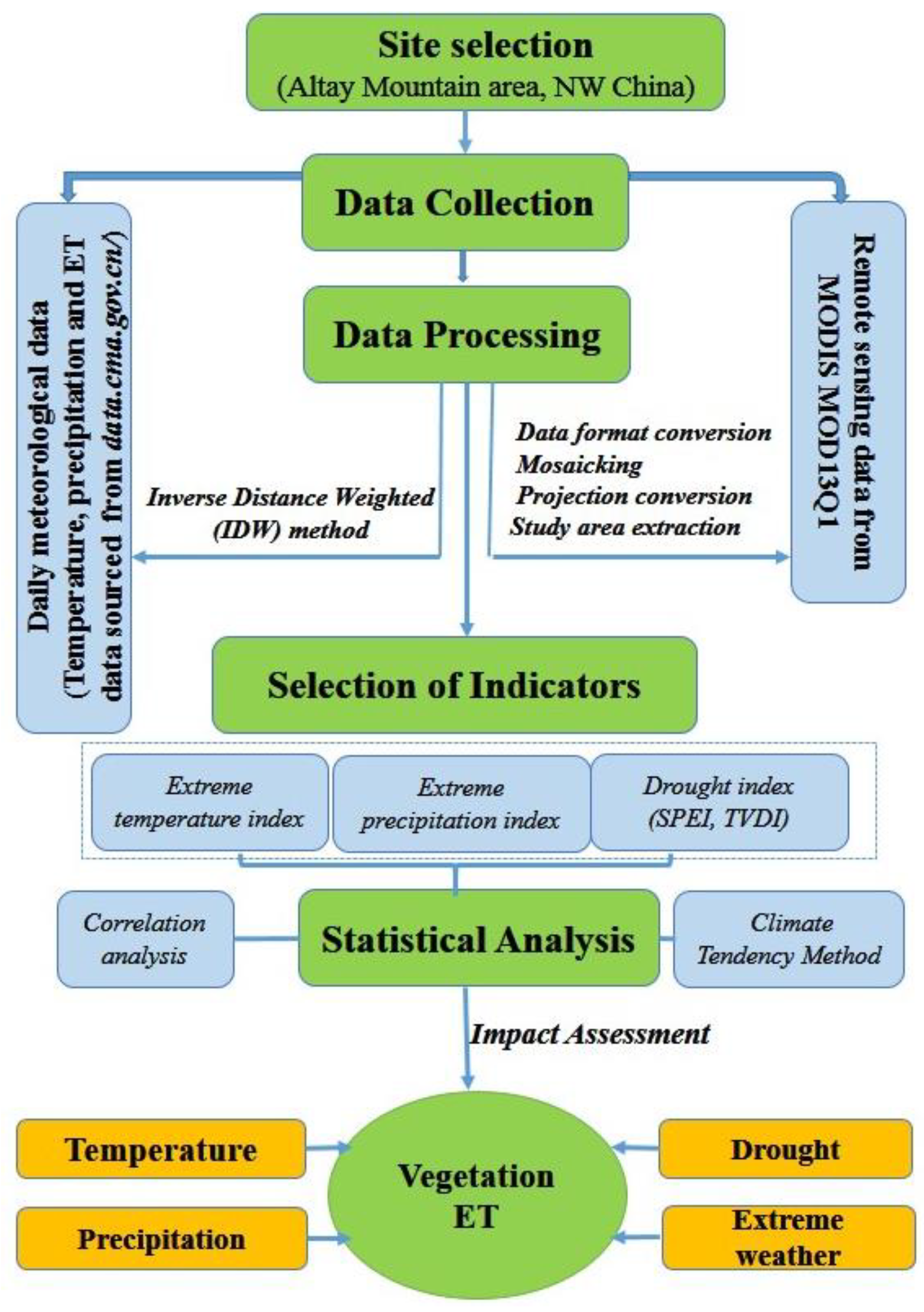
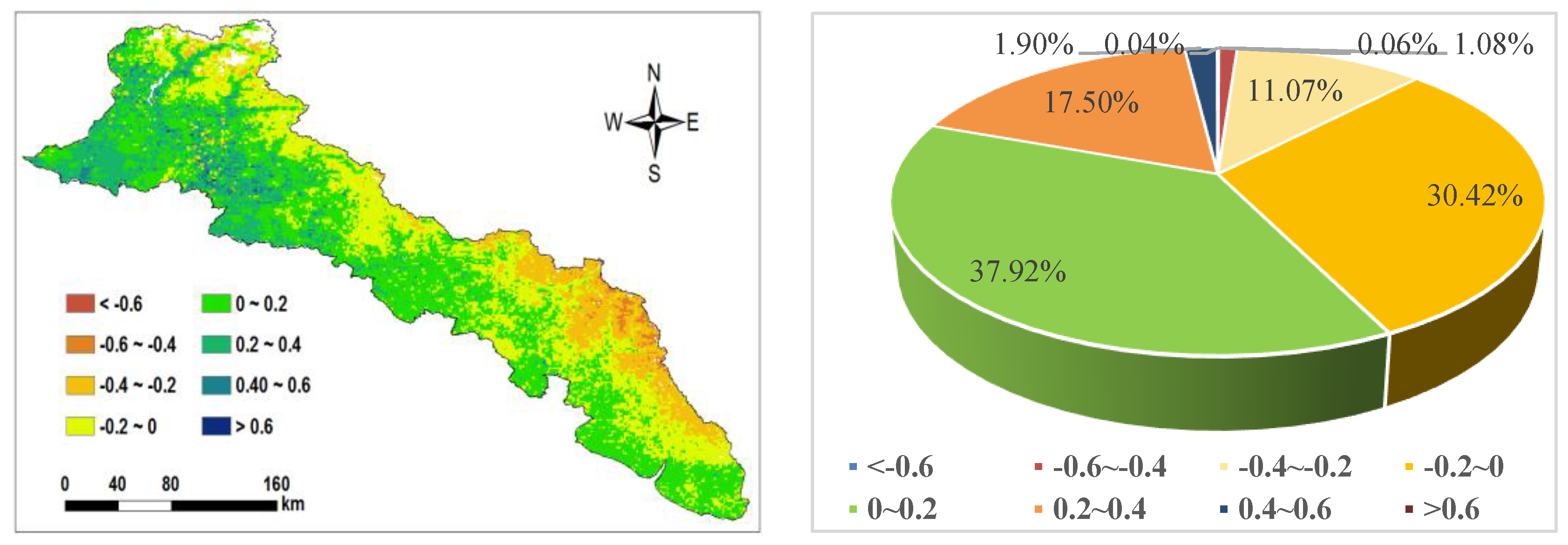

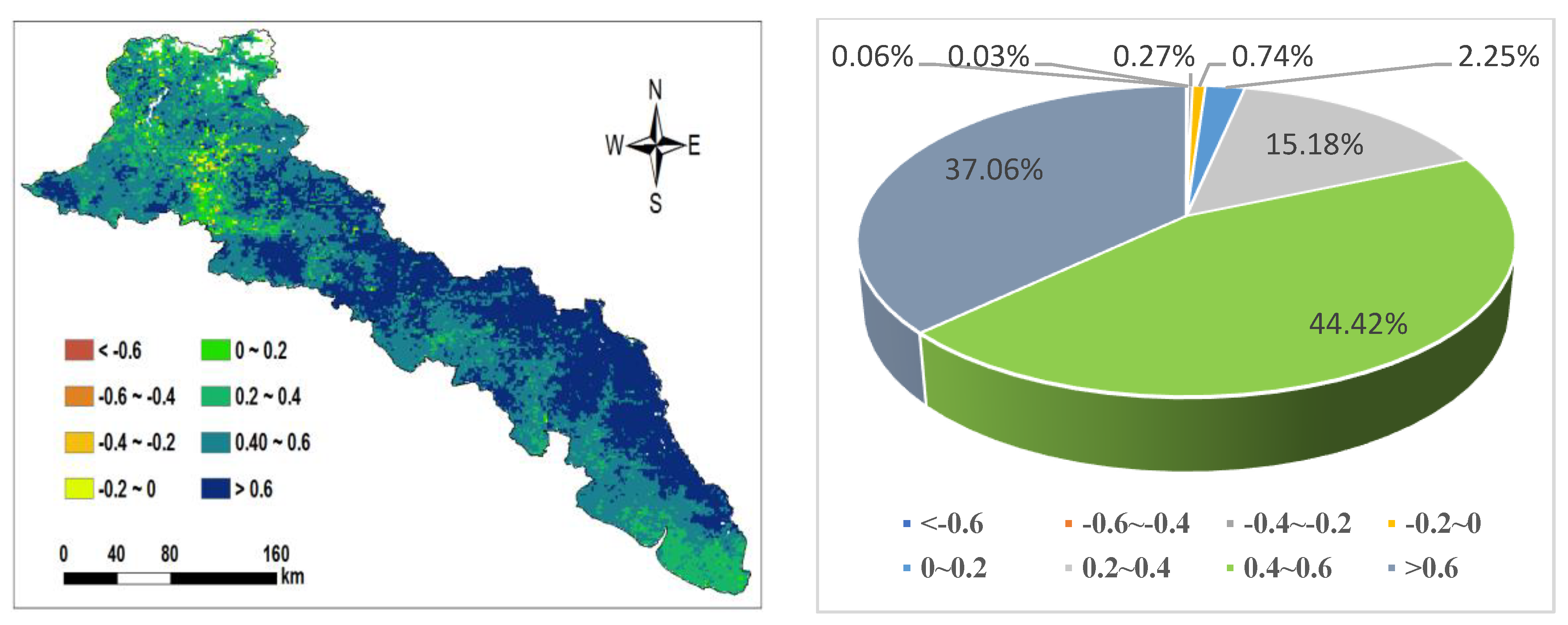
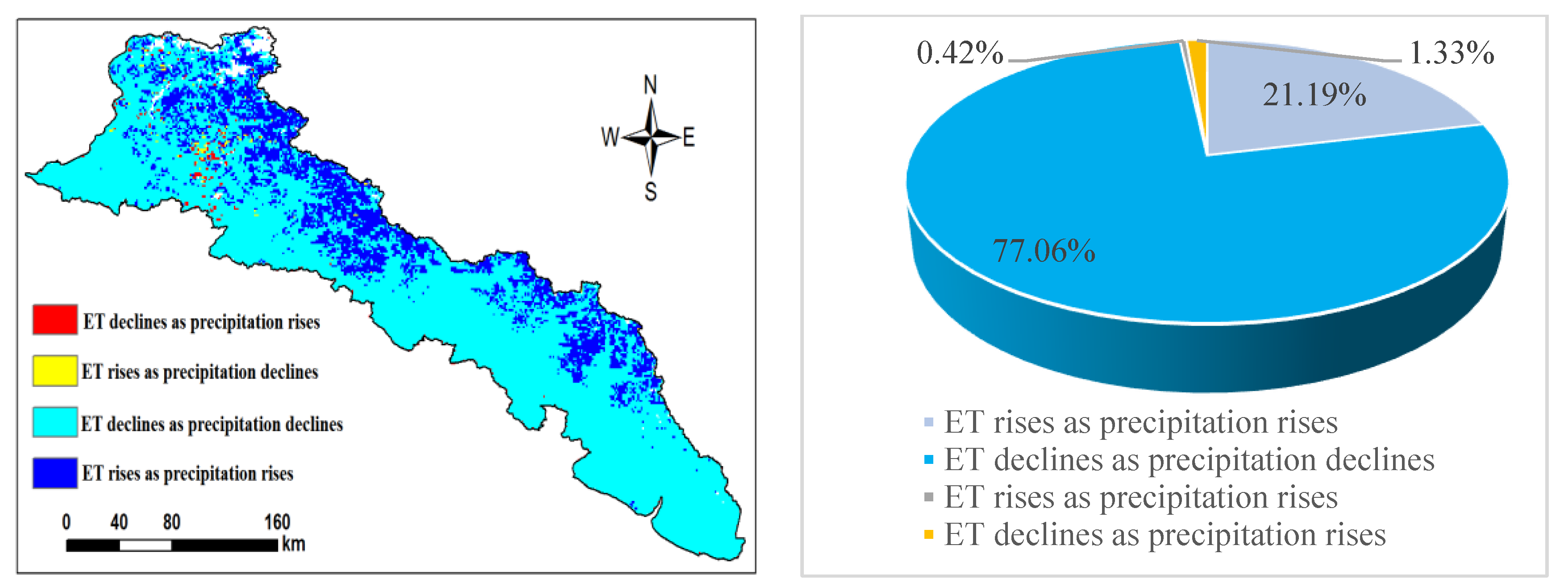





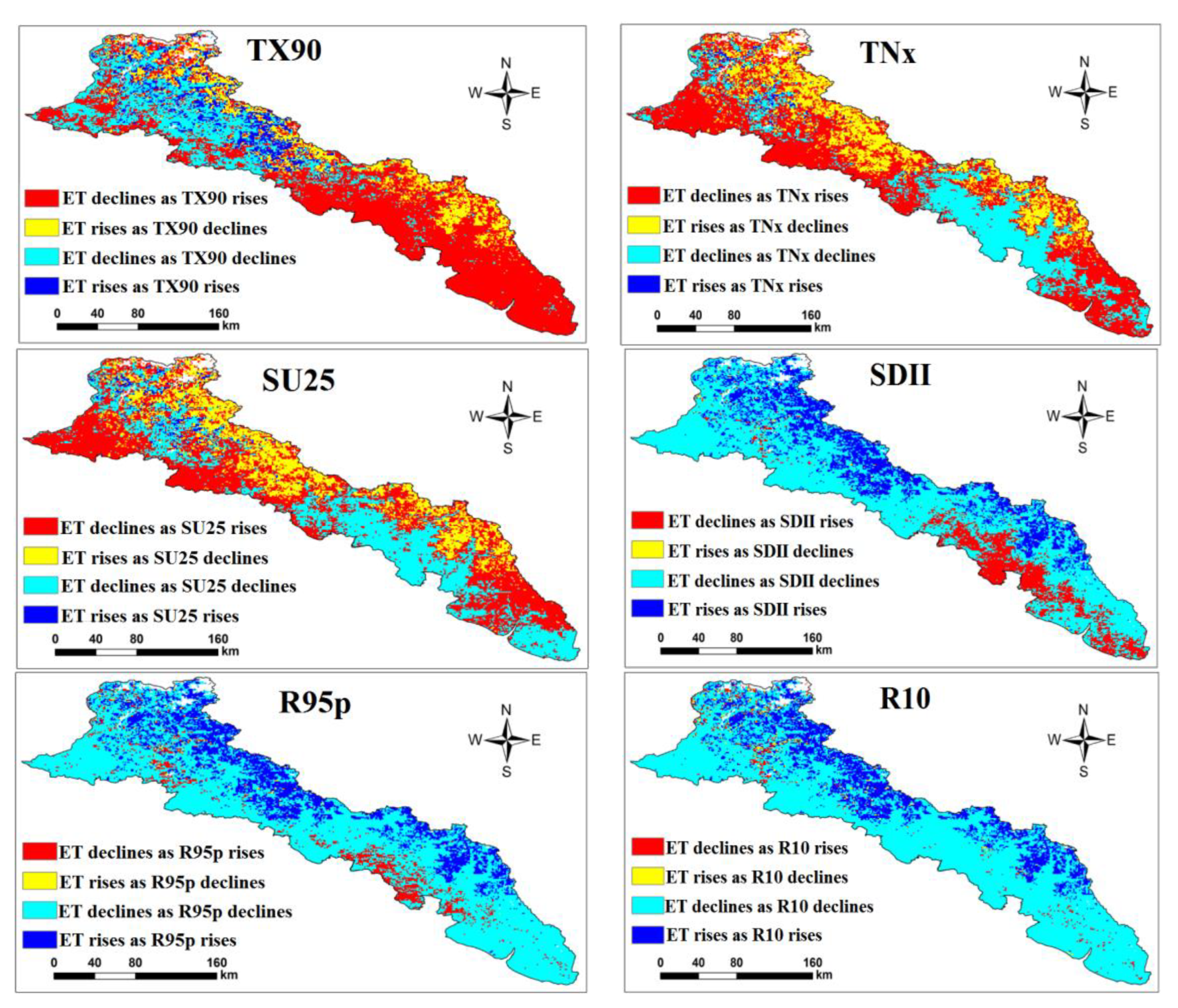
| Types | Abbreviation | Extreme Climate Index | Unit | Definition |
|---|---|---|---|---|
| Relative index | TX10 | Number of cold days | d | The number of days on which the daily maximum temperature in a year was less than the 10th percentile value for 1961–2017 |
| TN10 | Number of cold nights | d | The number of days on which the daily minimum temperature in a year was less than the 10th percentile value for 1961–2017 | |
| TX90 | Number of warm days | d | The number of days on which the daily maximum temperature in a year was less than the 90th percentile value for 1961–2017 | |
| TN90 | Number of warm nights | d | The number of days on which the daily minimum temperature in a year was less than the 90th percentile value for 1961–2017 | |
| Absolute index | ID | Freezing days | d | The number of days during the year when the maximum daily temperature is below 0 °C |
| FD | Number of frost days | d | The number of days during the year when the daily minimum temperature is below 0 °C | |
| SU | Summer days | d | The number of days during the year when the maximum daily temperature is greater than 25 °C | |
| TR | Number of hot nights | d | The number of days during the year when the daily minimum temperature is greater than 20 °C | |
| External index | TXn | Monthly maximum temperature | °C | The minimum value of the daily maximum temperature of each month |
| TNn | Monthly minimum temperature | °C | The minimum value of the daily minimum temperature of each month | |
| TXx | Daily maximum temperature | °C | The maximum value of the daily maximum temperature of each month | |
| TNx | Daily minimum temperature | °C | The maximum value of the daily minimum temperature of each month | |
| Other index | WSDI | Consecutive warm days | d | The number of days with a daily maximum temperature greater than the 90th percentile value for 1961–2017 and for more than 6 consecutive days |
| CSDI | Consecutive cold days | d | The number of days with a daily minimum temperature was less than the 10th percentile value for 1961–2017 and for more than 6 consecutive days | |
| GSL | Biological growing season | d | The number of first-appearing days in which the average daily temperature was above 5 °C for at least 6 consecutive days and the number of days in which the average temperature was below 5 °C for at least 6 consecutive days after 1 July | |
| DTR | Daily temperature ranges | °C | The difference between the maximum daily temperature and the minimum temperature during the year |
| Code | Name | Unit | Definition |
|---|---|---|---|
| RX1day | Maximum 1d precipitation | mm | The monthly maximum precipitation of 1 d |
| RX5day | Maximum 5 d precipitation | mm | The maximum precipitation for 5 consecutive days per month |
| R95p | Heavy precipitation | mm | The daily precipitation is greater than the total precipitation of the 95th percentile in the base period |
| R99p | Extreme precipitation | mm | The daily precipitation is greater than the total precipitation of the 99th percentile in the base period |
| PRCPTOT | Total annual precipitation | mm | Total annual daily precipitation |
| SDII | Precipitation intensity | mm/d | The ratio of total precipitation with daily precipitation ≥1.0 mm to the number of precipitation days |
| R10 mm | Number of moderate rain days | d | The number of days with daily precipitation ≥ 10 mm |
| R20 mm | Number of heavy rain days | d | The number of days with daily precipitation ≥ 20 mm |
| R25 mm | Number of rainstorm days | d | The number of days with daily precipitation ≥ 25 mm |
| CDD | Continuous dry days | d | The maximum number of consecutive days with daily precipitation < 1.0 mm |
| CWD | Continuous wet day | d | The maximum number of consecutive days with daily precipitation ≥1.0 mm |
| Grade | Types | SPEI Value |
|---|---|---|
| 1 | Non-drought | (−0.5, +∞) |
| 2 | Minor drought | (−1.0, 0.5] |
| 3 | Moderate drought | (−1.5, 1.0] |
| 4 | Severe drought | (−2.0, −1.5] |
| 5 | Extreme drought | (−∞, −2.0] |
| Index | Range of Correlation Coefficients | |||||||
|---|---|---|---|---|---|---|---|---|
| <−0.6 | −0.6~−0.4 | −0.4~−0.2 | −0.2~0 | 0~0.2 | 0.2~0.4 | 0.4~0.6 | >0.6 | |
| GSL | 0.09 ** | 2.59 ** | 18.38 * | 28.12 * | 26.43 * | 21.95 * | 2.33 * | 0.11 * |
| WSDI | 0.00 | 1.26 * | 11.37 * | 27.54 * | 36.72 ** | 21.36 | 1.72 | 0.04 |
| TX90 | 0.00 | 3.77 ** | 20.34 * | 44.68 ** | 24.62 * | 5.72 | 0.80 | 0.07 |
| TNx | 0.38 ** | 13.25 ** | 28.95 ** | 29.29 * | 19.48 | 7.78 | 0.83 | 0.03 |
| SU25 | 0.00 | 7.40 ** | 28.89 ** | 29.80 * | 26.97 * | 6.22 | 0.68 | 0.04 |
| SDII | 0.00 | 0.03 | 1.14 | 12.69 | 24.58 * | 39.51 | 19.21 ** | 2.84 ** |
| R95p | 0.00 | 0.04 | 0.55 | 7.15 | 29.73 * | 48.20 ** | 13.97 ** | 0.36 * |
| R10 | 0.01 | 0.07 | 0.80 | 2.93 | 35.50 ** | 54.92 ** | 5.71 * | 0.06 |
| Extreme Weather Indices | ET Rises as the Index Rises | ET Declines as the Index Declines | ET Rises as the Index Declines | ET Declined as the Index Rises |
|---|---|---|---|---|
| GSL | 19.69 | 31.13 | 1.92 | 47.26 |
| WSDI | 7.19 | 52.64 | 14.41 | 25.75 |
| TX90 | 8.21 | 23.00 | 13.39 | 55.39 |
| TNx | 1.54 | 26.59 | 20.06 | 51.81 |
| SU25 | 2.15 | 31.75 | 19.45 | 46.65 |
| SDII | 21.27 | 64.86 | 0.33 | 13.54 |
| R95p | 21.08 | 71.19 | 0.52 | 7.21 |
| R10 | 20.52 | 75.68 | 1.09 | 2.72 |
Disclaimer/Publisher’s Note: The statements, opinions and data contained in all publications are solely those of the individual author(s) and contributor(s) and not of MDPI and/or the editor(s). MDPI and/or the editor(s) disclaim responsibility for any injury to people or property resulting from any ideas, methods, instructions or products referred to in the content. |
© 2024 by the authors. Licensee MDPI, Basel, Switzerland. This article is an open access article distributed under the terms and conditions of the Creative Commons Attribution (CC BY) license (https://creativecommons.org/licenses/by/4.0/).
Share and Cite
Aili, A.; Hailiang, X.; Waheed, A.; Wanyu, Z.; Qiao, X.; Xinfeng, Z.; Peng, Z. The Dynamics of Vegetation Evapotranspiration and Its Response to Surface Meteorological Factors in the Altay Mountains, Northwest China. Sustainability 2024, 16, 8608. https://doi.org/10.3390/su16198608
Aili A, Hailiang X, Waheed A, Wanyu Z, Qiao X, Xinfeng Z, Peng Z. The Dynamics of Vegetation Evapotranspiration and Its Response to Surface Meteorological Factors in the Altay Mountains, Northwest China. Sustainability. 2024; 16(19):8608. https://doi.org/10.3390/su16198608
Chicago/Turabian StyleAili, Aishajiang, Xu Hailiang, Abdul Waheed, Zhao Wanyu, Xu Qiao, Zhao Xinfeng, and Zhang Peng. 2024. "The Dynamics of Vegetation Evapotranspiration and Its Response to Surface Meteorological Factors in the Altay Mountains, Northwest China" Sustainability 16, no. 19: 8608. https://doi.org/10.3390/su16198608
APA StyleAili, A., Hailiang, X., Waheed, A., Wanyu, Z., Qiao, X., Xinfeng, Z., & Peng, Z. (2024). The Dynamics of Vegetation Evapotranspiration and Its Response to Surface Meteorological Factors in the Altay Mountains, Northwest China. Sustainability, 16(19), 8608. https://doi.org/10.3390/su16198608






